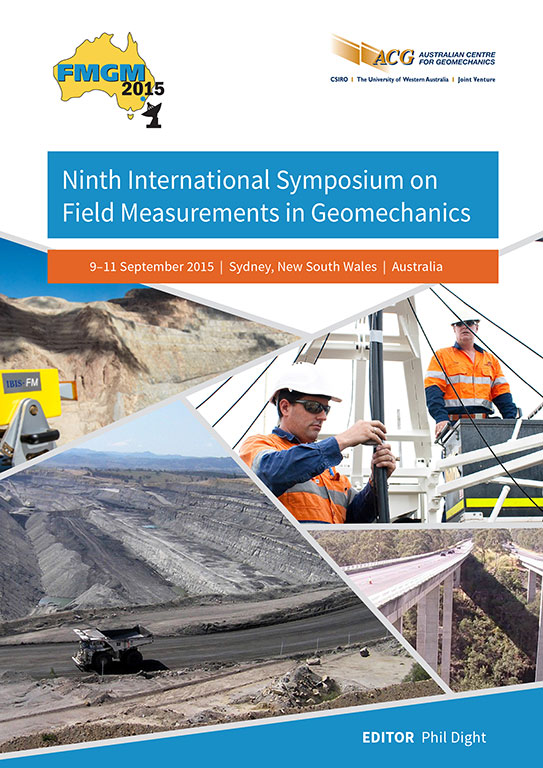Nude vibrating wire piezometer installations — no filter response zone and no engineered grout

|
Authors: Mazur, AJ; Schouten, LM; Lam, WY; Setiawan, PH |
DOI https://doi.org/10.36487/ACG_rep/1508_33_Mazur
Cite As:
Mazur, AJ, Schouten, LM, Lam, WY & Setiawan, PH 2015, 'Nude vibrating wire piezometer installations — no filter response zone and no engineered grout', in PM Dight (ed.), FMGM 2015: Proceedings of the Ninth Symposium on Field Measurements in Geomechanics, Australian Centre for Geomechanics, Perth, pp. 487-500, https://doi.org/10.36487/ACG_rep/1508_33_Mazur
Abstract:
This paper presents and compares the field performance of nude vibrating wire piezometer (VWP) installations with conventionally installed VWPs (with bentonite seal and filter response zone). The term ‘nude’ is used here to describe VWP instruments installed inside drill holes, without any filter response zone, bentonite seals or engineered grout materials. The success of this technique is dependent on the natural soil materials collapsing and enveloping the VWP sensor, forming a satisfactorily impermeable seal. Once the nude VWP instrument is lowered to the desired depth in a drill hole, the drill hole support casing is quickly removed and the surrounding saturated, soft, fine grained soils are allowed to collapse around and remould above the instrument to provide a relatively impermeable seal. Any remaining open area at the collar of the drill hole is backfilled with drill cuttings. In 2003 at the Sixth International Symposium on Field Measurements in Geomechanics, VWPs in fullygrouted boreholes were proposed as an acceptable and even superior alternative to the conventional filter sand/bentonite seal response zones commonly used with VWP instruments. Several authors have contributed further research over the ensuing twelve years, and the fully-grouted borehole technique has been adopted by a growing number of practitioners. We now put forward that under certain geotechnical conditions, the natural ground profile in soft soils can form an adequate low-permeability seal around the piezometer, and the engineered grout used with the fully-grouted borehole method may also be eliminated. In this case study, nude VWP performance was found to be characteristic of readings observed from conventionally (filter zone and bentonite seal) installed VWP instruments. Our findings are the result of full-scale field trials on a major Hong Kong reclamation project covering 150 hectares that were subject to staged loading using a sand surcharge. These piezometers were placed within low permeability, soft marine sediments, with data retrieved automatically during several stages of surcharge loading and unloading. The following arrangements were tested: Absolute readings, sensitivity, response times and dissipation signatures were compared in all instruments, in response to a rapidly applied and staged sand surcharge of 10 metres maximum height.
References:
Contreras, IA, Grosser, AT & VerStrate, RH 2007, ‘The use of the fully-grouted method for piezometer installation’, in J DiMaggio & P Osborn (eds), Proceedings of the Seventh International Symposium on Field Measurements in Geomechanics, American Society of Civil Engineers, Reston, VA, pp. 1-20.
Contreras, IA, Grosser, AT & VerStrate, RH 2008, ‘The use of the fully-grouted method for piezometer installation, Geotechnical News, June, pp. 30-37.
Das, BM 2002, Principles of Geotechnical Engineering, 5th edn, Brooks/Cole Publishing, Pacific Grove, CA.
Dunnicliff, J 1993, Geotechnical instrumentation for monitoring field performance, Wiley-Interscience, New York.
Fugro 2010, Fugro Geotechnical Services Ltd, Contract No. HY/2009/23, Ground Investigation Works for the Hong Kong Boundary Crossing Facilities, Final Factual Drill Hole Fieldwork Report, 8 volumes, GIU: 52156 to 52163.
Geotechnical Engineering Office 1994, Tung Chung: solid and superficial geology, map, Hong Kong Geological Survey, Hong Kong.
Geotechnical Engineering Office 1997, A review on some drained reclamation works in Hong Kong, GEO report no. 63, prepared by JSM Kwong, Hong Kong.
Geotechnical Engineering Office 2008, Hong Kong geology guide book, The Government of the Hong Kong Special Administrative Region, Hong Kong.
Highways Department 2010, Hong Kong–Zhuhai–Macao Bridge, The Government of the Hong Kong Special Administrative Region, viewed 26 February 2015,
Hong Kong Geological Survey 2002, Geology of Tung Chung and Northshore Lantau Island, report no. 6, prepared by RJ Sewell & PA Kirk, Geotechnical Engineering Office, Hong Kong.
Hong Kong Observatory, Predicted Tides at Chek Lap Kok, The Government of the Hong Kong Special Administrative Region, viewed 20 March 2015, .
Mikkelsen, PE 2002, ‘Cement-bentonite grout backfill for borehole instruments’, Geotechnical News, December, pp. 38-42.
Mikkelsen, PE & Green, GE 2003, ‘Piezometers in fully grouted boreholes’, in F Myrvoll (ed.), Proceedings of the Sixth International Symposium on Field Measurements in Geomechanics, CRC Press, London, pp. 545-553.
Simeoni, L, De Polo, F, Caloni, G & Pezzetti, G 2011, ‘Field performance of fully grouted piezometers’, Proceedings of the Eighth International Symposium on Field Measurements in Geomechanics, Technische Universität Braunschweig, Berlin, 15 p.
The Government of the Hong Kong special Administrative Region 2002, Port works design manual: part 3 – guide to design of reclamation, prepared by the Civil Engineering Office, Hong Kong.
Yungwirth, G, Preene, M, Dobr, M & Forero Garcia, F 2013, ‘Practical application and design considerations for fully grouted vibrating wire piezometers in mine water investigations’, in C Wolkersdorfer, A Brown & L Figueroa (eds), Proceedings of the International Mine Water Association Conference, International Mine Water Association Golden, Wendelstein,
pp. 229-236.
© Copyright 2026, Australian Centre for Geomechanics (ACG), The University of Western Australia. All rights reserved.
View copyright/legal information
Please direct any queries or error reports to repository-acg@uwa.edu.au
View copyright/legal information
Please direct any queries or error reports to repository-acg@uwa.edu.au